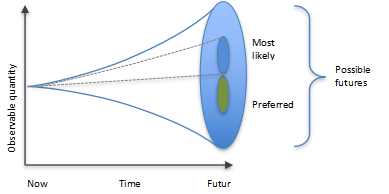Scenario Analysis
Suitable for Steps 5, 9
Duration
1 to 2 hours
Material Needed
Paper, pen, internet access, printer
Group size
Up to four
Objective
To help learners envision the future of a chosen topic or process.
Description
- After the learners have defined their topic, they should choose a specific point of time in the future around which they will concentrate their analysis. For example, five, ten or twenty years into the future. The farther the point of time in the future, the broader the analysis will be.
- After learners define this point, they should collect all available data concerning the past development of the chosen topic or process as well as estimations concerning its future.
- In the case of cotton production, learners may collect data on the expected growth of the world population, expected purchasing power, and fashion trends for the defined year.
- Knowing the past trends, and a business-as-usual scenario, learners can extend the graph for the behaviour of selected parameters in their diagram (see examplebelow) for the defined year in the future. Learners should plot the collected data on a graph for a best and a worst-case scenario.
- A funnel-shaped graph would result, depicting the possible futures in the selected time frame, including in a business as usual (BAU) scenario, and the best- and worst-case scenarios considering current knowledge.
- The scenario analysis can help simultaneously to decide which future we want to have and understand the conditions necessary to reach that.

Example
The IPCC Sixth Assessment Report presents the scenarios of future additional warming with 5 trends of future emissions.

Figure 10 Scenarios of global warming with future emissions, presented in IPCC AR 6
https://www.ipcc.ch/report/ar6/wg1/downloads/outreach/IPCC_AR6_WGI_Press_Conference_Slides.pdf
Contribution to Systems Thinking competence
Learners can get an idea of the future society, within a time frame of five to ten or even fifteen years, using documented evidence, current behaviour of the system, and by making realistic assumptions of the future development.
Learners understand how to predict the behavior of systems.

